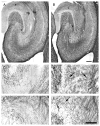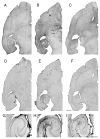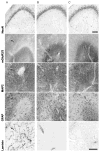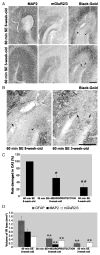Proepileptic influence of a focal vascular lesion affecting entorhinal cortex-CA3 connections after status epilepticus
- PMID: 18596544
- PMCID: PMC4879614
- DOI: 10.1097/NEN.0b013e318181b8ae
Proepileptic influence of a focal vascular lesion affecting entorhinal cortex-CA3 connections after status epilepticus
Abstract
In limbic seizures, neuronal excitation is conveyed from the entorhinal cortex directly to CA1 and subicular regions. This phenomenon is associated with a reduced ability of CA3 to respond to entorhinal cortex inputs. Here, we describe a lesion that destroys the perforant path in CA3 after status epilepticus (SE) induced by pilocarpine injection in 8-week-old rats. Using magnetic resonance imaging, immunohistochemical, and ultrastructural analyses, we determined that this lesion develops after 30 minutes of SE and is characterized by microhemorrhages and ischemia. After a longer period of SE, the lesion invariably involves the upper blade of the dentate gyrus. Adult rats treated with subcutaneous diazepam (20 mg kg for 3 days) did not develop the dentate gyrus lesion and had less frequent spontaneous recurrent seizures (p < 0.01). Young (3-week-old) rats rarely (20%) developed the CA3 lesion, and their spontaneous seizures were delayed (p < 0.01). To investigate the role of the damaged CA3 in seizure activity, we reinduced SE in adult and young epileptic rats. Using FosB/DeltaFosB markers, we found induction of FosB/DeltaFosB immunopositivity in CA3 neurons of young but not in adult rats. These experiments indicate that SE can produce a focal lesion in the perforant path that may affect the roles of the hippocampus in epileptic rats.
Figures









Similar articles
-
Impaired activation of CA3 pyramidal neurons in the epileptic hippocampus.Neuromolecular Med. 2005;7(4):325-42. doi: 10.1385/NMM:7:4:325. Neuromolecular Med. 2005. PMID: 16391389
-
Sequel of spontaneous seizures after kainic acid-induced status epilepticus and associated neuropathological changes in the subiculum and entorhinal cortex.Neuropharmacology. 2012 Oct;63(5):806-17. doi: 10.1016/j.neuropharm.2012.06.009. Epub 2012 Jun 18. Neuropharmacology. 2012. PMID: 22722023 Free PMC article.
-
Co-administration of subtherapeutic diazepam enhances neuroprotective effect of COX-2 inhibitor, NS-398, after lithium pilocarpine-induced status epilepticus.Neuroscience. 2015 Jan 22;284:601-610. doi: 10.1016/j.neuroscience.2014.10.021. Epub 2014 Oct 18. Neuroscience. 2015. PMID: 25453777 Free PMC article.
-
Recurrent seizures in the developing brain are harmful.Epilepsia. 1997 Jun;38(6):728-34. doi: 10.1111/j.1528-1157.1997.tb01244.x. Epilepsia. 1997. PMID: 9186257 Review. No abstract available.
-
Why is the developing brain more susceptible to status epilepticus?Epilepsia. 2009 Dec;50 Suppl 12(Suppl 12):25-6. doi: 10.1111/j.1528-1167.2009.02371.x. Epilepsia. 2009. PMID: 19941516 Free PMC article. Review. No abstract available.
Cited by
-
In vitro ictogenesis and parahippocampal networks in a rodent model of temporal lobe epilepsy.Neurobiol Dis. 2010 Sep;39(3):372-80. doi: 10.1016/j.nbd.2010.05.003. Epub 2010 May 7. Neurobiol Dis. 2010. PMID: 20452424 Free PMC article.
-
Neurosteroids and epilepsy.Curr Opin Neurol. 2010 Apr;23(2):170-6. doi: 10.1097/WCO.0b013e32833735cf. Curr Opin Neurol. 2010. PMID: 20160650 Free PMC article. Review.
-
Homocysteine potentiates seizures and cell loss induced by pilocarpine treatment.Neuromolecular Med. 2010 Sep;12(3):248-59. doi: 10.1007/s12017-009-8110-1. Epub 2009 Dec 22. Neuromolecular Med. 2010. PMID: 20033627
-
Defining "epileptogenesis" and identifying "antiepileptogenic targets" in animal models of acquired temporal lobe epilepsy is not as simple as it might seem.Neuropharmacology. 2013 Jun;69:3-15. doi: 10.1016/j.neuropharm.2012.01.022. Epub 2012 Feb 4. Neuropharmacology. 2013. PMID: 22342985 Free PMC article. Review.
-
Resilience to audiogenic seizures is associated with p-ERK1/2 dephosphorylation in the subiculum of Fmr1 knockout mice.Front Cell Neurosci. 2013 Apr 25;7:46. doi: 10.3389/fncel.2013.00046. eCollection 2013. Front Cell Neurosci. 2013. PMID: 23630463 Free PMC article.
References
-
- Avoli M, D’Antuono M, Louvel J, et al. Network and pharmacological mechanisms leading to epileptiform synchronization in the limbic system. Prog Neurobiol. 2002;68:167–207. - PubMed
-
- Pitkanen A, Sutula TP. Is epilepsy a progressive disorder? Prospects for new therapeutic approaches in temporal-lobe epilepsy. Lancet Neurol. 2002;1:173–81. - PubMed
-
- Morimoto K, Fahnestock M, Racine RJ. Kindling and status epilepticus models of epilepsy: Rewiring the brain. Prog Neurobiol. 2004;73:1–60. - PubMed
-
- Willoughby JO, Mackenzie L, Medvedev A, et al. Fos induction following systemic kainic acid: Early expression in hippocampus and later widespread expression correlated with seizure. Neuroscience. 1977;77:379–92. - PubMed
-
- Hsieh PF, Watanabe Y. Time course of c-FOS expression in status epilepticus induced by amygdaloid stimulation. Neuroreport. 2000;11:571–74. - PubMed
Publication types
MeSH terms
Substances
Grants and funding
LinkOut - more resources
Full Text Sources
Miscellaneous

